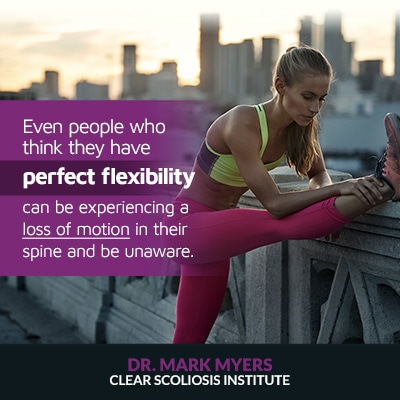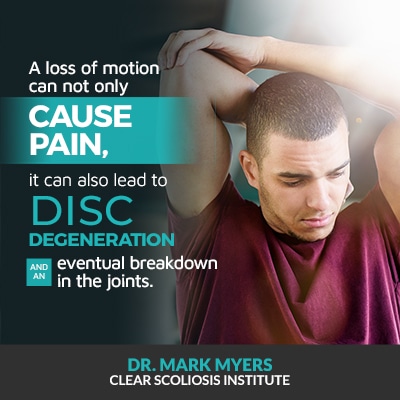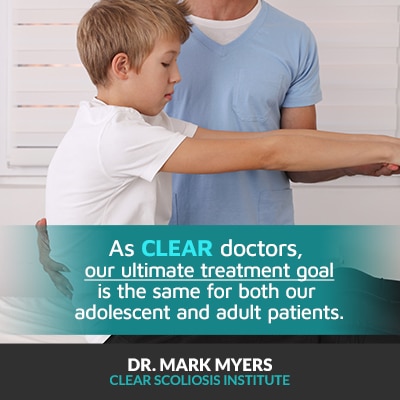
Neck problems are more prevalent in individuals with idiopathic scoliosis than they are in the general population. When it comes to treating scoliosis-related neck pain, we must identify the cause and take a two-pronged approach. First, we want to determine just how much of a loss of motion there is; next, we want to address the structural issues affecting the spine’s biomechanics. By improving the spine’s biomechanics, motion is increased and related symptoms, like pain, are often relieved.
One of the first steps to relieving any kind of pain is to gain an understanding of what’s causing it. Continue reading to find out just how we determine a patient’s range of motion and how that information helps us effectively treat scoliosis-related neck pain.
Here at the CLEAR Scoliosis Institute, use X-rays as well as digital measuring devices to examine the neck bending forward (flexion) and backward (extension) to determine just how much of a loss of motion a patient is experiencing. This information helps us plan our treatment approach moving forward.
We do this by having the patient bend their neck forward, lowering their chin to their chest, and take an X-ray in that position. Then we change their position to backwards neck extension by tilting their head back as far as possible and taking another X-ray. We also note if these movements are done with ease or discomfort.

Each individual vertebra should have normal motion. What we do is draw lines from the bottom of each vertebra on the X-ray, and as the patient bends their neck forward, all those lines should cross within six inches; when the head is tilted backwards, they should also all cross at six inches.
Most times, when we see someone with neck pain, we find that they have reduced motion in several of their vertebrae, and that can cause multiple issues.
Our CLEAR approach to treating scoliosis-related neck pain is to get motion back into those joints. This helps improve the overall biomechanics of the spine and improves function as the limited nerve supply returns.
Going back to the lines we draw on the X-ray from the bottom of each vertebrae to determine loss of motion, I like to think of those lines as a dimmer switch; when we see a loss of motion, it’s like the power’s been turned down, and that loss of power can cause additional problems.

A condition that often causes disc degeneration and other structural issues is what’s known as ‘military neck’. This is marked by the appearance of a straight neck or a neck that has lost its healthy curve.
When military neck is present, it increases the head’s weight on the neck and spine supporting it. This introduces adverse mechanical tension and can throw off the biomechanics of the entire spine. This is why, whether treating a patient with neck pain or with scoliosis, the exam and treatment plan covers the entire spine, not just the location of the pain or scoliosis.
The adverse mechanical tension associated with military neck can actually lead to deformation of the dura, cord, and nerve roots in the cervical canal. Military neck can also stretch and squeeze the neck’s arteries and that can reduce blood flow to the brain.
Patients with neck pain or scoliosis in their cervical or thoracic spine (upper back and neck) may experience tension headaches as an additional complication. When the neck’s muscles are tightened due to a loss of motion, tension is placed on the head, and this can cause crippling headaches, some reaching migraine level.
As a complex condition, each patient’s experience of living with scoliosis differs greatly, including the presence of pain and its varying degrees.

This difference in experiencing scoliosis-related pain between adolescents and adults is understood as a result of compression. For young people who are still growing, their spines are experiencing a lengthening motion, so they aren’t vulnerable to the compressive forces of gravity. In adults, this is the opposite.
Adults are no longer growing, which means any abnormal spinal curvature is causing compression on the spine, its nerves, tissues, and surrounding muscles. When the spine loses its healthy curves, they’re replaced with bad curves, and this is where treating the structural issue of those abnormal curves comes in.
As CLEAR doctors, our treatment goal is the same for both our adolescent and our adult patients - to address the underlying structural issues within the spine. Whether or not pain is an experienced symptom of a patient’s scoliosis, if the underlying structural issue isn’t addressed, the overall function of the spine will be compromised.

Each case of scoliosis differs greatly from one patient to the next. We address this variance by ensuring each treatment plan is fully customized to deal with the varying characteristics and related symptoms of each patient’s condition.
Here at CLEAR, our approach is to proactively address the underlying structural issue of the scoliosis and any scoliosis-related pain. Our treatment protocol can include a number of forms of treatment, including scoliosis-specific chiropractic adjustments, isometric exercises, and therapy. Some CLEAR-certified doctors use custom corrective 3D bracing as a complement to the CLEAR approach.
Scoliosis-specific isometric exercises can be a big part of our treatment plan and can include lying on spinal-molding rolls to improve the neck’s healthy curve. As the spine’s healthy curves are restored, adverse spinal tension is reduced, along with pain and other related symptoms.
Regardless of which forms of treatment we use, they’re all aimed at restoring proper spinal biomechanics by addressing the underlying cause of scoliosis neck pain.
Individuals with scoliosis experience a higher frequency of neck problems than the general population. These problems can lead to neck pain. To know how to successfully relieve neck pain, we must first understand the cause. A thorough exam must be performed to measure range of motion and look for potential structural issues.
If the spine’s biomechanics are affected and there is a loss of cervical lordosis (or cervical curve), it can stretch the spinal cord up to five to seven centimeters, causing adverse mechanical tension. This adverse mechanical tension not only affects the entire spinal cord, but it can also impact other areas of the body as well leading to various symptoms, such as headaches and migraines.
Pain can be minimized or completely relieved by restoring the spine’s biomechanics. CLEAR-certified doctors are highly trained in this area and can evaluate patients to determine the best course of treatment.
If you’re looking for a customized treatment plan to alleviate your neck pain, we recommend you find the CLEAR-certified doctor nearest you.
CLEAR-Institute.org - Scoliosis Side Effects: Myth vs. Reality
Clear-institute.org - Treating Scoliosis
Cailliet, Rene - Pain in the Neck and Arm
Disclaimer: The author’s views are his or her own and may not reflect the views of CLEAR Scoliosis Institute.

CLEAR provides a unique and innovative way of understanding scoliosis. Sign up to receive facts and information you won’t find anywhere else.

Hi,
I like your article, it is very informative.
Muscle contractions interfere with the sensitive nerve fibers at the base of the neck that lead to the brain and spinal cord. This muscle tension often plays a contributing factor to headache pain.
Interesting read. Thanks for the tips